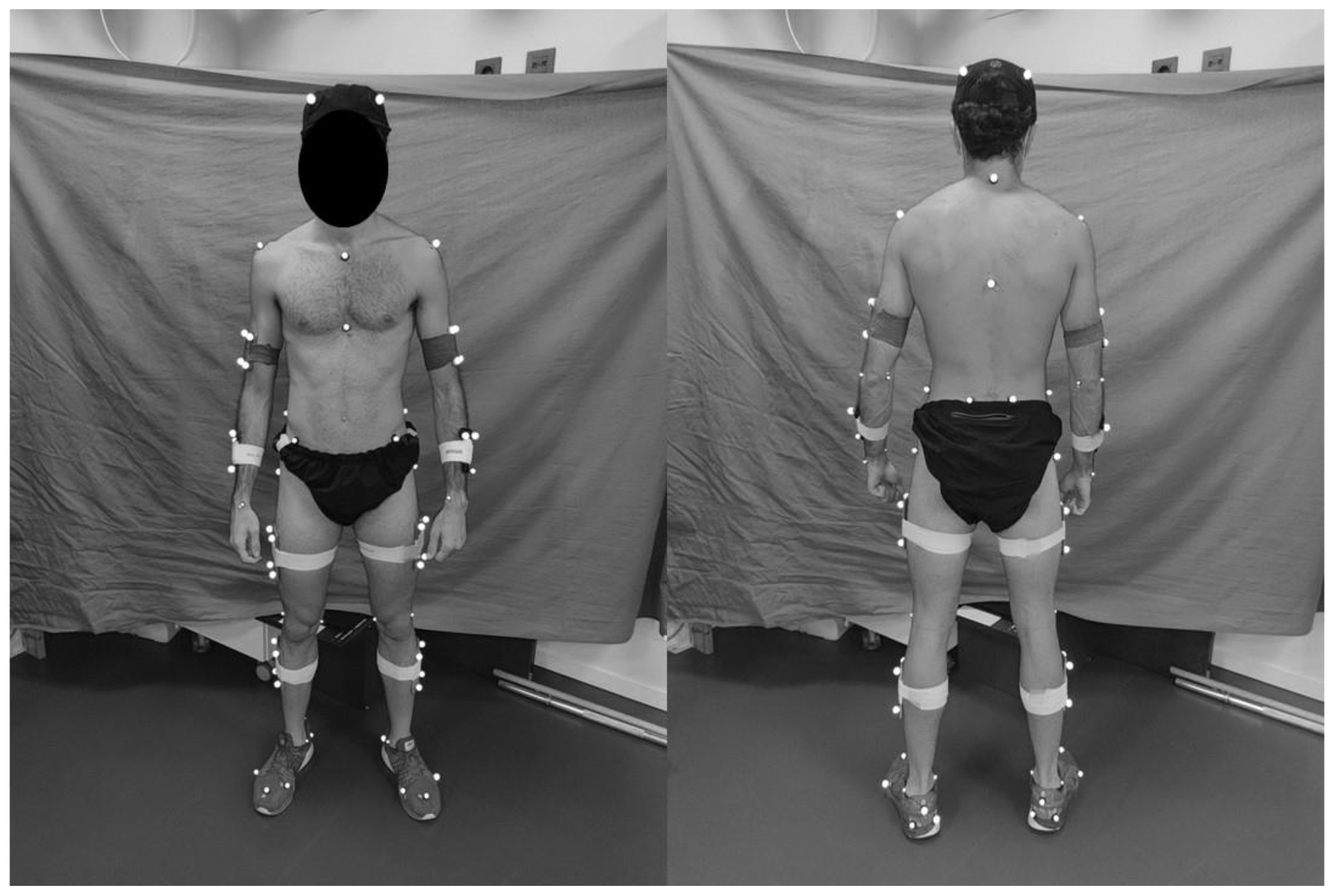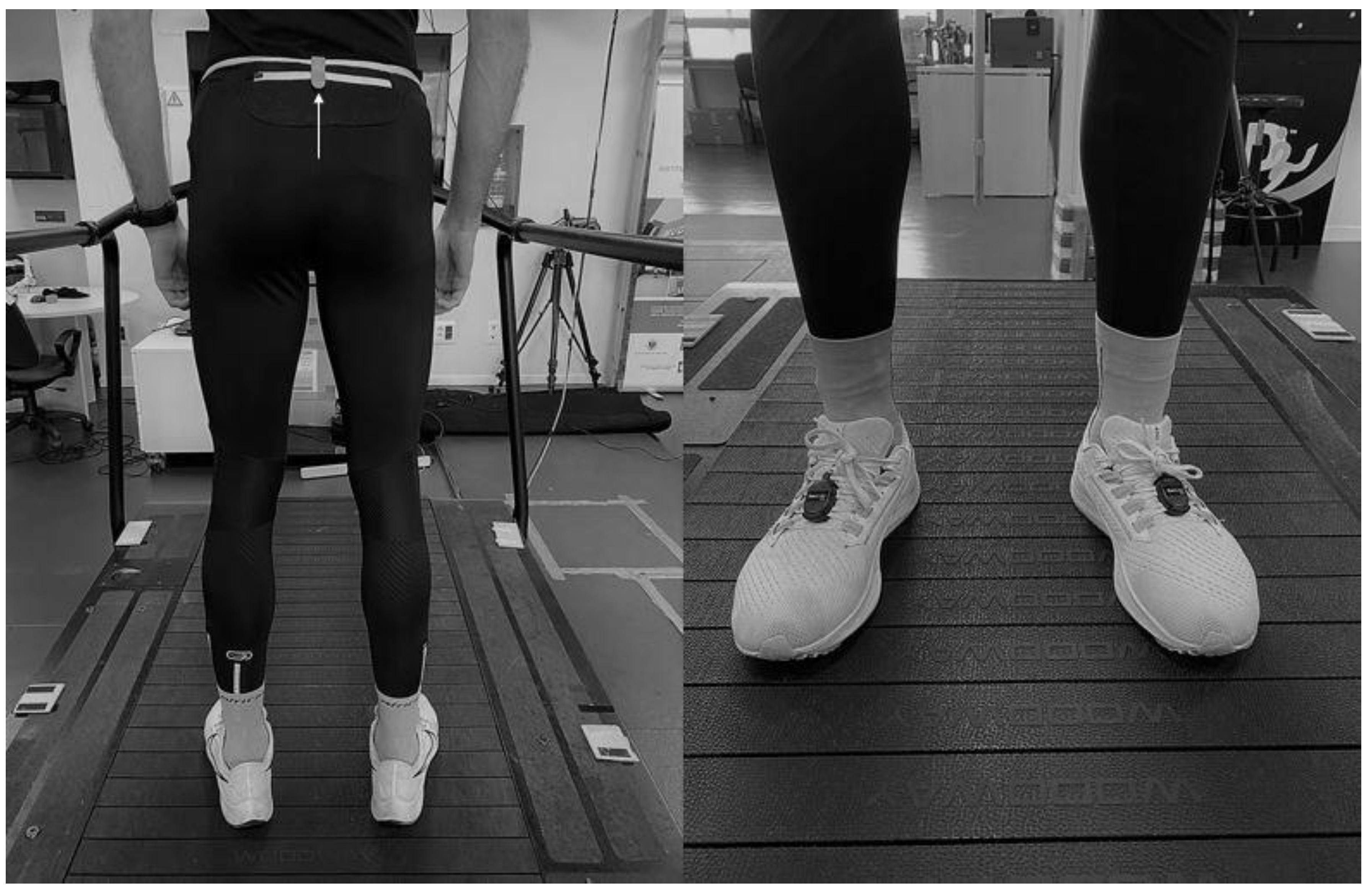RunScribe Sacral Gait Lab™ Validation for Measuring Pelvic Kinematics during Human Locomotion at Different Speeds
Abstract
1. Introduction
2. Materials and Methods
2.1. Experimental Design
2.2. Participants
2.3. Procedures
2.4. Statistical Analyses
3. Results
3.1. Vertical Oscillation
3.2. Pelvic Tilt
3.3. Pelvic Obliquity
3.4. Pelvic Rotation
4. Discussion
5. Conclusions
Author Contributions
Funding
Institutional Review Board Statement
Informed Consent Statement
Data Availability Statement
Acknowledgments
Conflicts of Interest
References
- Preece, S.J.; Mason, D.; Bramah, C. The coordinated movement of the spine and pelvis during running. Hum. Mov. Sci. 2016, 45, 110–118. [Google Scholar] [CrossRef] [PubMed]
- Schache, A.G.; Blanch, P.; Rath, D.; Wrigley, T.; Bennell, K. Running Lumbal Kinematic. Hum. Mov. Sci. 2002, 21, 273–293. [Google Scholar] [CrossRef]
- Folland, J.P.; Allen, S.J.; Black, M.I.; Handsaker, J.C.; Forrester, S.E. Running Technique is an Important Component of Running Economy and Performance. Med. Sci. Sports Exerc. 2017, 49, 1412–1423. [Google Scholar] [CrossRef] [PubMed]
- Schache, A.G.; Blanch, P.D.; Murphy, A.T. Relation of anterior pelvic tilt during running to clinical and kinematic measures of hip extension. Br. J. Sports Med. 2000, 34, 279–283. [Google Scholar] [CrossRef]
- Foch, E.; Reinbolt, J.A.; Zhang, S.; Fitzhugh, E.C.; Milner, C.E. Associations between iliotibial band injury status and running biomechanics in women. Gait Posture 2015, 41, 706–710. [Google Scholar] [CrossRef] [PubMed]
- Lavine, R. Iliotibial band friction syndrome. Curr. Rev. Musculoskelet. Med. 2010, 3, 18–22. [Google Scholar] [CrossRef] [PubMed]
- Fu, F.H.; Feldman, A. The biomechanics of running: Practical considerations. Tech. Orthop. 1990, 5, 8–14. [Google Scholar] [CrossRef]
- Lu, T.-W.; Chang, C.-F. Biomechanics of human movement and its clinical applications. Kaohsiung J. Med. Sci. 2012, 28 (Suppl. 2), S13–S25. [Google Scholar] [CrossRef]
- Topley, M.; Richards, J.G. A comparison of currently available optoelectronic motion capture systems. J. Biomech. 2020, 106, 109820. [Google Scholar] [CrossRef]
- Cuesta-Vargas, A.I.; Galán-Mercant, A.; Williams, J.M. The use of inertial sensors system for human motion analysis. Phys. Ther. Rev. 2010, 15, 462–473. [Google Scholar] [CrossRef]
- Fusca, M.; Negrini, F.; Perego, P.; Magoni, L.; Molteni, F.; Andreoni, G. Validation of a Wearable IMU System for Gait Analysis: Protocol and Application to a New System. Appl. Sci. 2018, 8, 1167. [Google Scholar] [CrossRef]
- Norris, M.; Anderson, R.; Kenny, I.C. Method analysis of accelerometers and gyroscopes in running gait: A systematic review. Proc. Inst. Mech. Eng. Part P J. Sports Eng. Technol. 2014, 228, 3–15. [Google Scholar] [CrossRef]
- Camomilla, V.; Bergamini, E.; Fantozzi, S.; Vannozzi, G. Trends Supporting the In-Field Use of Wearable Inertial Sensors for Sport Performance Evaluation: A Systematic Review. Sensors 2018, 18, 873. [Google Scholar] [CrossRef]
- Zhang, J.-T.; Novak, A.C.; Brouwer, B.; Li, Q. Concurrent validation of Xsens MVN measurement of lower limb joint angular kinematics. Physiol. Meas. 2013, 34, N63. [Google Scholar] [CrossRef]
- Robert-Lachaine, X.; Mecheri, H.; Muller, A.; Larue, C.; Plamondon, A. Validation of a low-cost inertial motion capture system for whole-body motion analysis. J. Biomech. 2020, 99, 109520. [Google Scholar] [CrossRef] [PubMed]
- Diraneyya, M.M.; Ryu, J.; Abdel-Rahman, E.; Haas, C.T. Inertial Motion Capture-Based Whole-Body Inverse Dynamics. Sensors 2021, 21, 7353. [Google Scholar] [CrossRef] [PubMed]
- Ruiz-Malagón, E.J.; Delgado-García, G.; Castro-Infantes, S.; Ritacco-Real, M.; Soto-Hermoso, V.M. Validity and reliability of NOTCH® inertial sensors for measuring elbow joint angle during tennis forehand at different sampling frequencies. Meas. J. Int. Meas. Confed. 2022, 201, 111666. [Google Scholar] [CrossRef]
- García-Pinillos, F.; Chicano-Gutiérrez, J.M.; Ruiz-Malagón, E.J.; Roche-Seruendo, L.E. Influence of RunScribe™ placement on the accuracy of spatiotemporal gait characteristics during running. Proc. Inst. Mech. Eng. Part P J. Sports Eng. Technol. 2020, 234, 11–18. [Google Scholar] [CrossRef]
- DeJong, A.F.; Hertel, J. Validation of Foot-Strike Assessment Using Wearable Sensors During Running. J. Athl. Train. 2020, 55, 1307–1310. [Google Scholar] [CrossRef]
- Lavcanska, V.; Taylor, N.F.; Schache, A.G. Familiarization to treadmill running in young unimpaired adults. Hum. Mov. Sci. 2005, 24, 544–557. [Google Scholar] [CrossRef]
- Schieb, D.A. Kinematic Accommodation of Novice Treadmill Runners. Res. Q. Exerc. Sport 1986, 57, 1–7. [Google Scholar] [CrossRef]
- American College of Sports Medicine. ACSM’s Health-Related Physical Fitness Assessment Manual; Lippincott Williams & Wilkins: Philadelphia, PA, USA, 2013. [Google Scholar]
- Pelvis Overview—Visual3D Wiki Documentation. C-Motion Inc., s. f. Available online: https://www.c-motion.com/v3dwiki/index.php/Pelvis_Overview (accessed on 14 January 2023).
- Koo, T.K.; Li, M.Y. A Guideline of Selecting and Reporting Intraclass Correlation Coefficients for Reliability Research. J. Chiropr. Med. 2016, 15, 155–163. [Google Scholar] [CrossRef] [PubMed]
- Hopkins, W.G. How to Interpret Changes in an Athletic Performance Test. Sportscience 2004, 8, 1–7. [Google Scholar]
- Hopkins, W.G.; Marshall, S.W.; Batterham, A.M.; Hanin, J. Progressive Statistics for Studies in Sports Medicine and Exercise Science. Med. Sci. Sports Exerc. 2009, 41, 3–13. [Google Scholar] [CrossRef] [PubMed]
- Cartón-Llorente, A.; Roche-Seruendo, L.E.; Jaén-Carrillo, D.; Marcen-Cinca, N.; García-Pinillos, F. Absolute reliability and agreement between Stryd and RunScribe systems for the assessment of running power. Proc. Inst. Mech. Eng. Part P J. Sports Eng. Technol. 2021, 235, 182–187. [Google Scholar] [CrossRef]
- Bolink, S.A.A.N.; Naisas, H.; Senden, R.; Essers, H.; Heyligers, I.C.; Meijer, K.; Grimm, B. Validity of an inertial measurement unit to assess pelvic orientation angles during gait, sit–stand transfers and step-up transfers: Comparison with an optoelectronic motion capture system*. Med. Eng. Phys. 2015, 38, 225–231. [Google Scholar] [CrossRef] [PubMed]
- Buganè, F.; Benedetti, M.G.; D’Angeli, V.; Leardini, A. Estimation of pelvis kinematics in level walking based on a single inertial sensor positioned close to the sacrum: Validation on healthy subjects with stereophotogrammetric system. Biomed. Eng. Online 2014, 13, 146. [Google Scholar] [CrossRef]
- Jamkrajang, P.; Saelee, A.; Suwanmana, S.; Wiltshire, H.; Irwin, G.; Limroongreungrat, W. Temporal Changes of Pelvic and Knee Kinematics during Running. J. Phys. Educ. Sport 2022, 22, 767–774. [Google Scholar] [CrossRef]
- Mitschke, C.; Kiesewetter, P.; Milani, T.L. The Effect of the Accelerometer Operating Range on Biomechanical Parameters: Stride Length, Velocity, and Peak Tibial Acceleration during Running. Sensors 2018, 18, 130. [Google Scholar] [CrossRef]


| RunScribe | Qualisys | Bias (95% CI) | SEE | SWC | ICC (95% CI) | r | |
|---|---|---|---|---|---|---|---|
| 5 km/h | |||||||
| Vertical oscillation (cm) | 25.9 (2.0) | 4.7 (1.2) | 21.1 (20.0 to 22.3) | 4.9 | 0.2 | 0.01 (−0.01 to 0.07) | 0.458 |
| Obliquity ROM (°) | 8.4 (1.8) | 9.5 (2.3) | −1.1 (−2.9 to 0.6) | 3.2 | 0.5 | −0.10 (−1.97 to 0.63) | −0.056 |
| Tilt ROM (°) | 7.0 (1.7) | 6.8 (2.4) | 0.2 (−1.7 to 2.3) | 3.3 | 0.5 | −1.62 (−12.5 to 0.25) | −0.429 |
| Rotation ROM (°) | 8.6 (2.9) | 7.9 (2.0) | 0.7 (−0.4 to 1.7) | 1.9 | 0.4 | 0.83 (0.46 to 0.95) | 0.758 * |
| Obliquity max rate (°/sec) | 75.9 (14.6) | 46.2 (13.5) | 29.7 (18.8 to 40.4) | 35 | 2.7 | 0.07 (−0.21 to 0.46) | 0.121 |
| Tilt max rate (°/sec) | 52.1 (16.6) | 49.4 (10.4) | 2.7 (−8.9 to 14.4) | 18 | 2.1 | 0.22 (−2.05 to 0.78) | 0.164 |
| Rotation max rate (°/sec) | 47.1 (8.7) | 67.3 (15.2) | −20.2 (−27.9 to −12.5) | 25 | 3.0 | 0.34 (−0.24 to 0.75) | 0.543 |
| 10 km/h | |||||||
| Vertical oscillation (cm) | 9.6 (2.2) | 10.0 (1.6) | −0.4 (−1.3 to 0.3) | 1.6 | 0.3 | 0.81 (0.47 to 0.94) | 0.724 * |
| Obliquity ROM (°) | 9.2 (3.4) | 14.5 (4.7) | −5.3 (−7.7 to −2.9) | 6.8 | 0.9 | 0.44 (−0.28 to 0.80) | 0.522 |
| Tilt ROM (°) | 11.3 (5.6) | 6.7 (2.0) | 4.6 (1.8 to 7.2) | 7.2 | 0.4 | 0.28 (−0.36 to 0.69) | 0.389 |
| Rotation ROM (°) | 11.1 (3.0) | 17.2 (5.2) | −6.1 (−11.8 to −4.9) | 11 | 1.0 | −0.32 (−1.12 to 0.40) | −0.312 |
| Obliquity max rate (°/sec) | 206 (92) | 141 (31) | 65 (16 to 114) | 105 | 6.2 | 0.37 (−0.39 to 0.78) | 0.533 |
| Tilt max rate (°/sec) | 367 (180) | 126 (53) | 241 (143 to 339) | 320 | 10.6 | 0.03 (−0.30 to 0.44) | 0.085 |
| Rotation max rate (°/sec) | 136 (40) | 128 (29) | 8.1 (−23 to 39) | 57 | 5.8 | −0.50 (−4.66 to 0.54) | −0.198 |
| 15 km/h | |||||||
| Vertical oscillation (cm) | 5.8 (1.5) | 8.2 (1.1) | −2.4 (−3.0 to 1.8) | 2.8 | 9.0 | 0.37 (−0.18 to 0.77) | 0.638 * |
| Obliquity ROM (°) | 16.3 (5.7) | 22.4 (7.2) | −6.1 (−9.6 to −2.7) | 8.4 | 1.4 | 0.577 (−0.22 to 0.86) | 0.590 * |
| Tilt ROM (°) | 13.4 (5.3) | 10.2 (3.9) | 3.2 (−0.2 to 6.6) | 7.0 | 0.8 | 0.09 (−1.04 to 0.65) | 0.056 |
| Rotation ROM (°) | 11.7 (3.2) | 22.9 (7.8) | −11.2 (−16.6 to −5.8) | 15 | 1.6 | −0.30 (−0.79 to 0.39) | −0.481 |
| Obliquity max rate (°/sec) | 269 (95) | 166 (31) | 103 (58 to 148) | 138 | 6.2 | 0.35 (−0.27 to 0.75) | 0.573 * |
| Tilt max rate (°/sec) | 388 (172) | 167 (48) | 221 (131 to 311) | 291 | 9.6 | 0.13 (−0.25 to 0.55) | 0.333 |
| Rotation max rate (°/sec) | 186 (74) | 167 (39) | 19 (−21.1 to 59.0) | 78 | 7.8 | 0.39 (−0.77 to 0.79) | 0.296 |
Disclaimer/Publisher’s Note: The statements, opinions and data contained in all publications are solely those of the individual author(s) and contributor(s) and not of MDPI and/or the editor(s). MDPI and/or the editor(s) disclaim responsibility for any injury to people or property resulting from any ideas, methods, instructions or products referred to in the content. |
© 2023 by the authors. Licensee MDPI, Basel, Switzerland. This article is an open access article distributed under the terms and conditions of the Creative Commons Attribution (CC BY) license (https://creativecommons.org/licenses/by/4.0/).
Share and Cite
Ruiz-Malagón, E.J.; García-Pinillos, F.; Molina-Molina, A.; Soto-Hermoso, V.M.; Ruiz-Alias, S.A. RunScribe Sacral Gait Lab™ Validation for Measuring Pelvic Kinematics during Human Locomotion at Different Speeds. Sensors 2023, 23, 2604. https://doi.org/10.3390/s23052604
Ruiz-Malagón EJ, García-Pinillos F, Molina-Molina A, Soto-Hermoso VM, Ruiz-Alias SA. RunScribe Sacral Gait Lab™ Validation for Measuring Pelvic Kinematics during Human Locomotion at Different Speeds. Sensors. 2023; 23(5):2604. https://doi.org/10.3390/s23052604
Chicago/Turabian StyleRuiz-Malagón, Emilio J., Felipe García-Pinillos, Alejandro Molina-Molina, Víctor M. Soto-Hermoso, and Santiago A. Ruiz-Alias. 2023. "RunScribe Sacral Gait Lab™ Validation for Measuring Pelvic Kinematics during Human Locomotion at Different Speeds" Sensors 23, no. 5: 2604. https://doi.org/10.3390/s23052604
APA StyleRuiz-Malagón, E. J., García-Pinillos, F., Molina-Molina, A., Soto-Hermoso, V. M., & Ruiz-Alias, S. A. (2023). RunScribe Sacral Gait Lab™ Validation for Measuring Pelvic Kinematics during Human Locomotion at Different Speeds. Sensors, 23(5), 2604. https://doi.org/10.3390/s23052604







